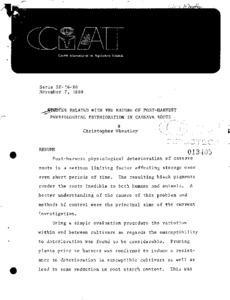Studies related with the nature of post-harvest physiological deterioration in cassava roots
Abstract
Post-harvest physiological deterioration of cassava roots is a serious limiting factor affecting storage over even short periods of time. The resulting black pigments render the roots inedible to both humans and animals. A better understanding of the causes of this problem and methods of control were the principal aims of the current investigation. Using a simple evaluation procedure the variation within and between cultivars as regards the susceptibility to deterioration was found to be considerable. Pruning plants prior to harvest was confirmed to induce a resistance to deterioration in susceptible cultivars as well as lead to some reduction in root starch content. This was found to continue for considerable periods after pruning (>9 weeks). Ecosystem studies show that there is a large environmental component in the variation in deterioration susceptibility within one cultivar and that physiological stresses in general (climatic, biotic or edaphic) can lead to a reduction in susceptibility. Further data on harvests in Popayan support this. Biochemical studies provided evidence for the existance of a phenol (scopoletin) which fluorescences blue in UV light, appears in fresh tissue a few hours after harvest and rapidly accumulates. Applications of scopoletin to fresh tissue induce blue-black vessel pigmentation within 6 hours. Tissues from pre-pruned (resistant) plants do not accumulate scopoletin to the same extent but respond to the exogenous compound. An enzyme inhibitor presents scopoletin accumulation suggesting that its appearance is an enzymic process. Further investigation into a combination of cultural practices and appropriate storage techniques with regard to root quality should enable the goal of successful cassava root storage to be achieved.

